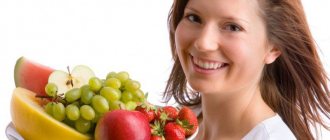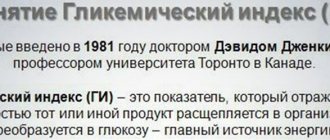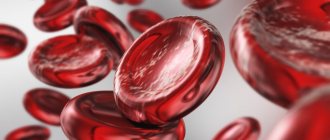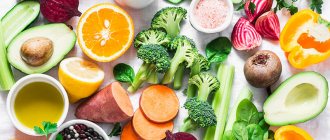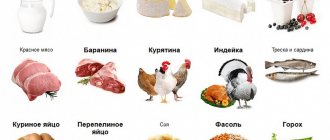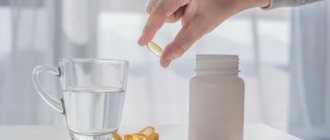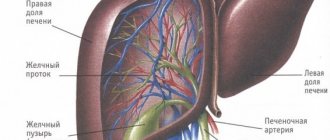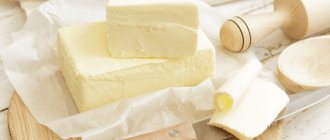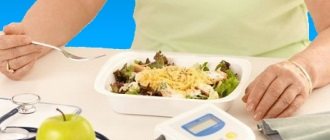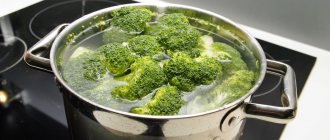Anemia (or anemia) is a condition in which the concentration of hemoglobin in the blood decreases and, accordingly, the number of red blood cells - blood cells that carry oxygen to organs and tissues and remove carbon dioxide from them.
This happens in the vast majority of cases when iron deficiency occurs. Because of this, hemoglobin molecules, which are the most important part of red blood cells, cease to be formed in the required quantity.
Iron is an essential element in red blood cells; it is what holds oxygen molecules in order to transport it from the lungs to every cell of the body.
As a result, the transport function of the blood is disrupted: the reduced number of red blood cells cannot cope with the saturation of all cells with oxygen, and hypoxia (oxygen starvation) occurs. This threatens the development of a large number of pathologies, because from a lack of oxygen and an excess of unremoved carbon dioxide, all organs suffer, and first of all the brain, heart, liver, and the immune system is greatly suppressed.
Symptoms of anemia
The initial form of anemia hardly manifests itself as alarming symptoms. However, as iron deficiency increases in the body, the following complaints of a rather general nature appear:
- Severe weakness
- Increased fatigue
- Pale skin and sclera
- Exercise-related dyspnea
- Headache
- Dizziness
- Tachycardia
- Decreased appetite
- Discomfort in the stomach area
- Belching
- Stool disorders
More specific symptoms characteristic of moderate to severe anemia are:
- Violation or change in taste preferences (desire to eat clay, ice, starch, chalk, lime, paper, toothpaste, etc.)
- Glossitis (inflammation of the tongue)
- Dry mouth
- Hair loss, brittleness and peeling of nails
- Angulitis (cracks in the corners of the mouth)
- Stomatitis
- Multiple caries
- and others.
How to create a menu?
Breakfast options
- any porridge;
- steamed or fried cutlet;
- soft-boiled egg;
- stewed meat;
- pudding;
- boiled fish;
- vegetable puree;
- fried liver;
- hard cheese;
- tea with milk.
Lunch options
- first course: cabbage soup, borscht, fish soup, milk soup, meatball soup (beef or chicken), vegetable soup;
- second course: liver or kidneys (fried, stewed), meat (steamed, fried, boiled, baked, stewed), vegetable cutlets.
- dessert: jelly, fruit salad or fresh fruit, cottage cheese.
- drink: compote, jelly, tea.
Afternoon snack
- coffee or tea with milk;
- biscuits;
- fruits.
Dinner
- cottage cheese dish;
- pudding;
- cheese;
- meat dish;
- a fish dish;
- caviar;
- vegetable stew;
- scrambled eggs;
- milk, rose hip decoction, tea.
For the night
- kefir;
- bifidocus;
- curdled milk;
- Ryazhenka
A sample menu for the day might look like this:
- In the morning you can eat fried liver with stewed vegetables and drink herbal tea.
- Snack on an apple or egg.
- In the afternoon, prepare vegetable soup, cabbage salad, boiled chicken breast, eat an orange.
- During the afternoon snack, drink a rosehip decoction and eat a hematogen (bar).
- For the evening, oatmeal, cottage cheese or cottage cheese casserole are suitable.
- You can drink kefir at night.
Causes of anemia
A decrease in iron content in the body can occur due to many reasons. However, the following factors stand out:
- Insufficient intake of iron from food
- Unbalanced diet
Vegetarian diet
- Poor appetite and malnutrition
- Strict diets and fasting
- Acceleration of iron consumption processes in the body
- Periods of increased growth in children and adolescents
Pregnancy
- Lactation period
- Sports activities
- Chronic and acute blood loss
- Periods of increased growth in children and adolescents
Pregnancy
- Lactation period
- Sports activities
- Iron absorption disorders
- Diseases of the gastrointestinal tract
Worm infestations
- Hormonal imbalances
- Various diseases
- Deficiency in the diet of substances that ensure the absorption of iron from food (protein, ascorbic acid, B vitamins)
What should be excluded from the diet
And now about what food should not be in the diet for anemia. “Flour products (except whole grain bread) and baked goods, carbonated and alcoholic drinks, coffee, tea, sausages and smoked meats, pickles, lard, margarine - all these are undesirable products for people suffering from anemia,” says Daria Kirillova.
Try to cleanse your diet of all processed foods and minimize the amount of sugar. “Refined foods, fast food, and excess sweets contribute to the development of essential nutritional deficiencies,” says Rachel Link. “As a result, we suffer from fatigue, weight gain, as well as inflammatory bowel disease and candidiasis. With candidiasis, the normal pH balance is disrupted and the mucous membrane of the gastrointestinal tract suffers. This, in turn, interferes with the normal absorption of nutrients. This is why candidiasis and anemia are linked, especially in women. To get rid of candidiasis, try eliminating all sugars from your menu for a while. Sweets are an ideal environment for harmful microorganisms.”
Here is a list of foods to avoid if you have low hemoglobin levels.
- Sugar.
- Processed grain.
- Dark chocolate. Although it is rich in iron, it also contains tannins, which interfere with iron absorption.
- Regular dairy products. Calcium binds to iron and can lead to poor absorption of the latter.
- Coffee and tea. Excessive consumption of these drinks can block iron absorption, so reduce the amount of coffee to one cup per day and tea to four cups.
How to eat if you have anemia
Meals for anemia should be divided, 4-6 times a day . The last evening meal no later than 2 hours before bedtime . The protein content in the diet is usually increased to 110-120 g per day, and fast carbohydrates (sugar, confectionery, baked goods) are limited.
Particular attention is paid to minimizing the amount of saturated animal fat, which reduces iron absorption. Restrictions also apply to salt consumption (up to 6 g per day).
It is best to cook dishes by steaming, boiling, stewing and baking. Everything fatty, smoked, spicy, salty and spicy is excluded from the diet. You need to drink enough fluid, about 1.5 liters per day.
Unwanted Products
Nutritionists do not recommend including foods that make it difficult for the body to absorb iron into the diet for anemia. These include:
- fatty, dairy products, baked flour products, strong tea, coffee and Coca-Cola;
- dishes containing brine and acetic acid, due to their destructive effect on the blood;
- canned goods;
- foods high in calcium;
- alcoholic drinks, which often lead to complications in the form of blood clotting disorders.
The prohibited foods listed above are harmful to people suffering from anemia.
Menu for anemia
If you have anemia, it is important to include foods that are dietary sources of iron in your menu. However, it is equally important to use substances in the diet that improve the absorption of iron into the body. It is known that the presence of acids in foods (ascorbic, succinic, citric, etc.) activates the processes of iron absorption.
And these substances worsen them:
- Phytates
- Phosphates
- Carbonates
- Polyphenols
- Calcium
- Tannin
Iron is found in many foods, but the degree of its absorption varies. Iron is absorbed best from beef, a little worse from poultry and fish. Iron from liver, eggs, dairy products and grains has the smallest percentage of absorption. The best plant sources of iron, due to the presence of ascorbic and other acids in the composition, are:
- Cabbage (fresh and pickled)
- Carrot
- Potato
- Pumpkin
- Tomatoes
- Beet
List of foods and dishes recommended and undesirable for anemia:
Foods that reduce iron absorption:
- Whole cow's milk
- Cheese
- Eggs
- Bran
- Alimentary fiber
- Tea coffee
Foods that contain iron and increase its absorption:
- Lean meat, poultry
- Liver
- Fish
- Seafood
- Cereals (buckwheat, millet, barley, oatmeal)
- Freshly squeezed fruit juices (in moderation)
- Fruits and berries (blueberries, currants, peach, persimmon, quince, raw or baked apples)
Reviews and results
- “... I suffer from heavy periods for 5-6 days, so this diet therapy is a salvation for me. After 3-4 weeks of taking iron supplements and dietary nutrition, everything returns to normal, but I am always afraid of my critical days”;
- “...My daughter and her friends went on some special diet to lose weight. Despite my persuasion, I ate this way for more than a month, until I started fainting. The doctor was called. The result is anemia, low hemoglobin, headaches, and changes in the skin. They prescribed a diet, I buy all the products containing iron, but I’m afraid that after recovery she won’t find another diet.”
The importance of protein in anemia
The main cause of anemia is insufficient synthesis in the body of hemoglobin molecules that make up red blood cells - erythrocytes. Hemoglobin is a protein whose complex structure contains iron atoms. Therefore, a prerequisite for the formation of hemoglobin molecules is the presence in the body of these two components in sufficient quantities - protein and iron. Without each of them, hemoglobin simply will not have anything to “build” from.
How to increase iron absorption?
In order for iron to be better absorbed by the body, you must use the following recommendations:
- Meat and liver should be eaten with vegetables, beets and carrots are especially useful.
- Ascorbic acid helps iron be better absorbed, so it is useful to wash down cereals, fish and meat dishes with orange juice.
- Consuming 50-70 g of honey per day will allow iron to be better absorbed in the body. Honey is also useful for boosting immunity.
- Experts recommend that patients with anemia eat pears, which increase the concentration of hemoglobin in the blood.
It is enough to follow these simple recommendations for anemia to recede or not appear at all.
Diso Nutrimoon
Protein for treatment and rehabilitation
An easily digestible, tasteless protein mixture, a source of proteins and amino acids necessary for the body to fight illness, recover from injuries, illnesses and operations.
More details
Scientists have long established that the absorption of iron requires the presence of several factors: ascorbic acid, B vitamins and a sufficient amount of protein.
It is the transferrin protein that is responsible for the absorption of iron in the intestine and its transfer to the site of hemoglobin synthesis. If there is not enough protein in the diet, iron absorption will be significantly reduced. That is, protein is needed both for the absorption of iron and directly for the synthesis of hemoglobin.
Microelements to enhance hematopoiesis
The following microelements stimulate the formation of red cells and hemoglobin:
- zinc: offal, beef, mushrooms, eggs, beans, cereals, yeast, Dutch cheese;
- copper: cereals, black currants, watermelon, cranberries, strawberries, beans, liver, beef, horseradish;
- cobalt: beans, cereals, nuts, fish, offal, milk, gooseberries, parsley, apricots, cherries, pears, raspberries;
- manganese: beans, greens, cereals, pumpkin, raspberries, beets, black currants, cranberries.
Microelements are very important in the treatment and prevention of anemia
Diso Nutrimun for anemia
With anemia, it is important to take care of both the quantity of protein and its quality. The most useful protein will be one that is highly bioavailable. In addition, it is fundamentally important that protein products do not contain animal fats and other components that reduce the absorption of iron.
Traditional food products containing complete animal proteins, unfortunately, do not fully meet these requirements. Therefore, including the Diso Nutrimun protein mixture in dishes is an ideal solution for getting protein that is beneficial for anemia.
What is Nutrimun?
Nutrimun protein mixture contains concentrated milk proteins, which have the highest biological value and are easily digestible. Nutrimun protein is balanced in amino acid composition, which makes its biological value the highest.
Nutrimun protein mixture is a real help in providing the body with protein in case of many digestive disorders, when you have to follow a special restrictive diet, eat frequently and in small portions.
How does he help?
Nutrimun is a protein that can be easily digested even with a lack of digestive enzymes, will also be easily absorbed by the body and will bring maximum benefit. Use Nutrimun along with traditional foods in the diet prescribed by your doctor, add it to any food and drink.
Nutrimun, as an additional source of complete protein, will definitely help speed up your recovery and restore impaired functions. Diso Nutrimun does not contain saturated animal fats or substances that reduce iron absorption, which distinguishes it from other protein products.
Medical recommendations
You should check with your doctor about what you can eat if you have anemia. However, proper nutrition alone is not enough to get rid of anemia; you will need to take medications. However, diet plays a huge role. Products entering the body should be rich not only in iron, but also in other beneficial substances, vitamins and microelements.
The human body should receive about 20 mg of iron per day. It will be absorbed better if you combine it with vitamin C. For example, it is useful to eat buckwheat porridge and wash it down with pomegranate juice, or meat with plum juice.
Anemia in a child: how to increase hemoglobin?
Anemia is a dangerous disorder in childhood, so it must be dealt with correctly. Thus, oxygen starvation of the child’s internal organs will lead to a delay in his development, both mental and physical. The baby becomes whiny, aggressive, lethargic.
If such symptoms are detected, you must contact your pediatrician and take a blood test. Often it is anemia that leads to the occurrence of such symptoms. If a nursing mother leads a healthy lifestyle and eats healthy food, then before the age of six months, anemia in children does not often develop. After all, iron from breast milk is absorbed very well by the baby’s body. Therefore, if anemia develops in a breastfed child, then the mother’s diet needs to be changed. When introducing complementary foods, you should adhere to the basic rules, making the child’s menu healthy and varied. The table should contain such products as: beets, meat, apples, buckwheat, juices (apple and pomegranate).
When the child grows up, the problem of anemia will be solved by itself, but only if the baby eats properly. By the age of 3, a preschooler’s diet expands significantly. It includes a wide variety of products that do not cause allergies.
Anemia during pregnancy and lactation: how to increase hemoglobin?
A woman carrying a fetus must eat properly. This will cover the needs of not only her body, but also the needs of the child growing inside her. Iron deficiency will lead to the development of anemia in both the pregnant woman and the child. This is very dangerous, as it causes retardation of intrauterine growth and development.
Therefore, the expectant mother should adhere to the following recommendations:
- You need to drink green tea, it allows iron to be better absorbed. It is best to avoid drinking black tea.
- Pomegranate juice should be consumed in small volumes, as its excess can cause stool retention.
- Products containing iron will help maintain normal hemoglobin levels in the blood of the pregnant woman and child.
- If you have frequent diarrhea or vomiting, you should consult your doctor. This problem cannot be ignored.
Permitted and prohibited products
Let's start, perhaps, with the list of prohibited products, because it is much smaller than the list of permitted ones.
The following should not be consumed or should be severely limited:
- fatty and spicy sauces;
- fatty meats;
- sweets with a lot of cream;
- any alcohol;
- spicy snacks (chips, crackers);
- pickles in large quantities;
- sausages and sausages of dubious quality;
- energy drinks, sweet carbonated water.
It is also recommended to exclude store-bought mayonnaise; it can be easily made at home.
List of allowed foods for diet No. 11:
- rye bread, wheat bread, various types of pastries;
- pasta (it is better to choose whole grain);
- all porridges made with water and milk;
- any fruits, vegetables, berries, herbs;
- eggs;
- lean meat, fish;
- milk, fermented milk products (especially cottage cheese);
- nuts, dried fruits;
- natural butter and vegetable oils.
Berry and fruit smoothies, cottage cheese casseroles, milkshakes, milk porridge with a piece of butter, vegetable salads with vegetable oil dressing will have a positive effect on the body's condition. You can drink tea, coffee, cocoa.
Try to prepare food from high-quality products, use your 3000 kcal per day and space in the stomach with maximum benefit.
Iron deficiency anemia in children
Why are iron supplements necessary for IDA? What are the advantages of the latest generation drugs? Why should iron supplements be taken for a long time?
| Blood picture in chronic iron deficiency anemia. Severe hypochromia of erythrocytes, anisocytosis, poikilositosis, schizocils, the presence of polychromatophils |
Anemia is a pathological condition characterized by a decrease in red blood cell mass, often in combination with a decrease in the number of red blood cells per unit volume of blood.
There are many causes of anemia; For children, iron deficiency anemia (IDA) is most typical. IDA is characterized by the presence of small hypochromic red blood cells and depletion of iron stores in the body. The prevalence of iron deficiency in children at an early age, according to WHO, ranges from 17.5 to 30%.
The following reasons for the development of iron deficiency in children can be identified.
- Insufficient iron stores at birth. Premature babies, as well as children from mothers who suffered from anemia during pregnancy, are at risk for developing IDA. The condition of the placenta is also of great importance, since the positive balance of iron in the fetus is due to the perfect transport mechanisms of the placenta.
- Insufficient intake of iron from food and impaired absorption in the gastrointestinal tract. What matters is not so much the iron content in the product, but the efficiency of its absorption and assimilation. Iron is absorbed in the duodenum and jejunum, therefore, with various diseases of the digestive tract (chronic enteritis, malabsorption syndrome), iron deficiency can also develop due to impaired absorption.
- Increased need for iron due to growth, intensive processes of tissue differentiation, maturation of various organs and systems, and an increase in circulating blood volume. The need for iron is especially high during traction, puberty and during the formation of menstrual function in teenage girls.
- Excessive loss of iron by the body. This is primarily blood loss: bleeding of various locations (for diseases of the digestive tract - ulcerative processes, polyps, vascular anomalies, nasal), helminthic infestation, menstruation in teenage girls. Excessive loss of iron can occur with severe allergic manifestations on the skin due to the loss of a microelement with exfoliating epithelium, with frequent acute respiratory viral infections in children, since viruses and bacteria use the child’s iron for their metabolic processes.
It is important to note that in young children the causes of iron deficiency are, as a rule, insufficient iron stores and poor nutrition, and in older children - blood loss and sudden traction.
Pathophysiological aspects
Since iron absorption is limited, most people's dietary intake barely meets the body's current needs; iron deficiency can easily develop as a result of illness or poor nutrition. This process consists of several stages.
Stage 1. Iron loss exceeds iron intake. Against the background of a negative iron balance, its reserves in the bone marrow are gradually depleted. Although serum iron and hemoglobin levels remain normal, serum ferritin levels decrease (below 20 ng/mL). As iron stores are depleted, a compensatory increase in transferrin concentration occurs (as evidenced by an increase in iron-binding capacity).
Stage 2: Depleted iron stores no longer provide erythropoietic function to the bone marrow. While plasma transferrin levels rise, serum iron levels decrease, resulting in an increasing deficiency in red blood cell production. Erythropoiesis is impaired when iron levels are below 50 mcg% and transferrin saturation is below 16%. The concentration of ferritin receptors in the serum increases (more than 8.5 mg/l).
Stage 3. Anemia with apparently normal red blood cells and red blood cell indices.
Stage 4. Development of microcytosis and then hypochromia.
Stage 5: Iron deficiency is accompanied by symptoms of tissue disorders.
Clinical manifestations
The idea of the clinical status of a patient with anemia depends on the underlying disease and the form of anemia (acute or chronic). IDA is a chronic condition. The manifestation of anemia per se is explained using pathophysiological mechanisms. Most symptoms of IDA are a reflection of cardiovascular and gas exchange changes that compensate for the decrease in red blood cell mass. The severity of symptoms depends on the speed of development of anemia (with the slow development of anemia, characteristic of iron deficiency conditions, there is enough time for the full development of compensatory mechanisms) and its duration. Even moderate anemia is often asymptomatic. The child may complain of fatigue, shortness of breath and palpitations, especially after physical activity. In severe anemia, symptoms persist even at rest, and the patient cannot tolerate physical activity. If the hemoglobin level is less than 75 g/L, resting cardiac output increases markedly as both heart rate and stroke volume increase. Symptoms of heart failure develop when myocardial reserve is depleted. Consequently, the severity of the patient’s condition is determined primarily by the severity of cardiovascular disorders.
Symptoms of moderate to severe anemia extend to other organ systems. The patient often complains of dizziness and headaches, tinnitus, and even fainting is possible. The person becomes irritable, sleep is disturbed, and concentration decreases. Because blood flow to the skin is reduced, hypersensitivity to cold may develop. Symptoms also arise from the gastrointestinal tract - a sharp decrease in appetite, dyspeptic disorders (nausea, changes in the nature and frequency of stool), primarily due to the shunting of blood bypassing the vascular bed of the internal organs. In teenage girls, the menstrual cycle is disrupted, which manifests itself in the form of amenorrhea or heavy bleeding.
The main sign of anemia is pale skin. However, its information content is limited by other factors that determine skin color.
Therefore, the most informative sign of anemia is the pallor of visible mucous membranes - the mucous membrane of the oral cavity, the nail bed and the conjunctiva of the eyelids. The color of the skin on the folds of the palmar surface is also considered informative - if they do not differ in color from the surrounding skin, then the patient’s hemoglobin level is usually less than 80 g/l.
The development of pallor of the skin during anemia is explained by two factors: the first is, undoubtedly, a decrease in the level of hemoglobin in the blood, the second is the shunting of blood bypassing the vessels of the skin and other peripheral tissues, which promotes increased blood supply to vital organs. Redistribution of blood flow is one of the important mechanisms for compensating for anemia.
Other clinical symptoms of anemia include the already mentioned tachycardia, significant fluctuations in pulse pressure, systolic ejection murmur over the atria, decreased mental and physical activity, children become irritable, quickly get tired, their sleep is restless, and their appetite is reduced.
With IDA, the usual symptoms of anemia are accompanied by signs specific to iron deficiency. With prolonged iron deficiency, perverted appetite (eating chalk, dirt, paints) and sense of smell appear (like the strong smells of gasoline, paints, varnishes, eating ice (pagophagia), glossitis, cheilitis, koilonychia (thinned, striated, brittle nails) develop. With deficiency iron, the activity of the immune system decreases due to a decrease in the synthesis of IL-2 and T-killers; children are more likely to get ARVI, which, in turn, aggravates the existing iron deficiency.
The diagnosis is confirmed by laboratory data. The criterion for diagnosing IDA is microcytic, hypochromic, normoregenerative anemia. IDA is characterized by anisocytosis, thrombocytosis, decreased serum iron levels (less than 13 mmol/l), total iron-binding capacity of serum is unchanged or increased, serum ferritin level is less than 15 ng/ml, transferrin saturation is less than 16%, erythrocyte protoporphyrin level is increased, Hb level A2 is reduced, irritation of the red line is noted in the bone marrow (erythrocytes: granulocytes = 1:1 - 1:2), a typical lack of iron reserves and ring-shaped sideroblasts in the bone marrow.
The differential diagnostic search includes thalassemia, lead poisoning, anemia in chronic diseases, congenital disorders of iron metabolism (transferrin deficiency, impaired iron utilization, impaired iron reutilization), hemosiderosis, including Goodpasture's syndrome, copper deficiency.
Principles of treatment of IDA in children
- Elimination of the causes underlying the development of iron deficiency.
- Therapy for IDA should be carried out with iron supplements, since it is impossible to compensate for iron deficiency in this condition with diet therapy alone; true iron deficiency is not accompanied by a deficiency of vitamins B12, B6, and folic acid.
- The goal of therapy with iron supplements is to eliminate iron deficiency in the body, and not just to normalize hemoglobin levels, so the treatment period is long (at least 3 months).
- IDA therapy is carried out mainly with oral iron supplements.
- Blood transfusions for IDA are carried out only for health reasons.
Diet therapy for IDA in children
It is now generally accepted that it is impossible to eliminate iron deficiency in the body through diet therapy alone. This is due to the fact that the absorption of iron from food is limited - 1.8-2 mg (no more than 2.5 mg) of iron per day - even with a balanced diet appropriate for age and consumption of sufficient amounts of foods high in iron. (For comparison: a healthy child, depending on age, loses from 0.15 to 0.6 mg of iron per day, a girl during menstruation - 15-50 mg) When taking modern iron supplements, it is absorbed 20 times better. Diet therapy should be one of the components of IDA therapy in children.
On the other hand, it is very important to focus not on the iron content in food, but on its form. It is the form of iron that determines the percentage of its absorption and assimilation and, consequently, the effectiveness of therapy. Of the various forms of iron, the easiest to absorb is heme iron, a complex organic compound in which iron is found in hemoglobin; inorganic compounds - iron salts - are absorbed by the body much worse. Iron in heme is actively captured by the cells of the intestinal mucosa and absorbed unchanged. The processes of heme absorption in the intestine do not depend on the acidity of the environment and the activity of food enzymes. Iron from cereals, vegetables, and fruits is absorbed much less well due to the presence of ferroabsorption inhibitors in them, such as oxalates, phosphates, tannin and others. Compare: the absorption coefficient of iron from beef (heme iron) is 17-22%, from fruit - no more than 3%. The degree of absorption of iron from animal products also depends on the form of iron-containing compounds. Thus, from the liver, where iron compounds are presented in the form of ferritin and transferrin, iron is absorbed in significantly smaller quantities than from meat products, although the total iron content in the liver is 3 times higher than in meat. Therefore, including liver in the diet to eliminate iron deficiency or for preventive purposes does not make any sense. Thus, the diet should be as rich as possible in foods that contain iron in the form of heme (beef tongue, rabbit meat, beef).
It should also be noted that meat, liver and fish improve the absorption of iron from fruits and vegetables when consumed simultaneously.
The absorption of iron from cereals, legumes, tubers, vegetables, and fruits is much lower, since they contain iron in non-heme form, and largely depends on the content in the diet of substances that inhibit or potentiate the absorption of iron. Ascorbic acid, meat, poultry, fish products, as well as substances that reduce the acidity of food (for example, lactic acid) enhance the absorption of non-heme iron. Soy protein and polyphenols found in tea, coffee, nuts and legumes reduce the absorption of non-heme iron. Despite the high iron content in some products of plant origin, they cannot meet the high iron requirement characteristic of a growing organism, since iron from them is absorbed much less well than from animal products. Recommendations to consume large quantities of fruit juices, apples, pomegranates, buckwheat and other products in order to replenish iron depots in IDA also cannot be considered justified. A diet balanced in terms of the main ingredients allows you to “cover” only the physiological need of the child’s body for iron, but does not eliminate iron deficiency in any way and should be used in combination with iron supplements in the treatment of IDA. However, a complete and balanced diet plays an important role in preventing the development of iron deficiency in a child’s body during all periods of childhood.
Drug therapy for IDA
The main goal of IDA therapy is to eliminate iron deficiency in the child’s body. This is achieved by taking iron-containing medications. The main requirements for iron preparations are a sufficient content of elemental iron and the absence of side effects and complications. Currently, there is a sufficient selection of iron preparations on the Russian pharmaceutical market, which expands the physician’s capabilities and allows taking into account the individual characteristics of patients when prescribing treatment (Table 1). In particular, convenient forms for young children have appeared - drops and syrup (ferrum lek, maltofer, actiferrin, hemofer).
All drugs are registered and approved for use in the Russian Federation.
Modern iron supplements are divided into two groups:
- ionic iron-containing preparations (salts, polysaccharide iron compounds);
- non-ionic compounds, i.e. preparations represented by the hydroxide-polymaltose complex of ferric iron (ferrum lek, maltofer).
The absorption of iron from a medicinal product depends on the content of elemental (active) iron in it. The largest amount of elemental iron is contained in preparations in which iron is presented in the form of fumarate (ferretab, ferronate) or ferrous sulfate (actiferrin, ferro-foil, hemofer prolangatum, ferro-gradumet). Currently, a new generation of iron preparations has appeared, which include drugs represented by the hydroxide-polymaltose complex of ferric iron (maltofer, ferrum lek). The peculiarity of these drugs is that the entry of iron from the intestine into the blood occurs through active absorption, in contrast to iron salt compounds, the absorption of which occurs along a concentration gradient. This is important because it eliminates the possibility of an overdose of iron preparations containing ferric iron hydroxide-polymaltose complex.
Iron salt preparations in the intestinal lumen interact with food components and other medications, which complicates the absorption of iron. Therefore, this group of iron supplements is prescribed one hour before meals. However, against the background of pronounced free radical stress that occurs when iron interacts with the intestinal mucosa during its diffusion, the damaging effect of iron compounds on the intestinal mucosa increases, which is manifested by dyspeptic disorders, including necrosis of the mucosa. If iron salt preparations are poorly tolerated, they can be taken with food, which will reduce side effects, but iron absorption, in turn, will worsen. Iron salt preparations should not be taken with tea, milk or combined with certain medications (tetracyclines, chloramphenicol, calcium supplements, antacids, penicillamine), since this reduces the absorption of iron.
Nonionic iron preparations, as studies have shown, do not interact with food components and medications, which allows the use of these preparations without disturbing the diet of children (the preparations can be added to food, juices) and treatment regimens for concomitant pathologies (if there is a need for such treatment ).
The daily therapeutic dose of iron preparations should be sufficient to normalize hemoglobin levels and replenish iron reserves in the bone marrow, which for iron salt preparations is 3-6 mg/kg/day of elemental iron in two or three doses. Iron hydroxide-polymaltose complex (ferrum lek) is prescribed at a dose of 3-6 mg/kg/day in one or more (at the patient’s request) doses.
Adverse reactions when taking iron supplements
The most common side effects observed during treatment with ferrodrugs (Table 2): metallic taste in the mouth, darkening of tooth enamel, allergic skin rashes, dyspeptic disorders as a result of irritation to the mucous membrane of the digestive tract, especially the intestines (loose stools, nausea, vomiting ). Therefore, the initial doses of drugs should be 1/2-1/3 of the therapeutic dose, followed by increasing them to the full dose over several days in order to avoid the occurrence of severe side effects. If you are intolerant to the salt preparation, it can be replaced with an iron hydroxide-polymaltose complex, the use of which does not result in the above-described effects. Iron hydroxide-polymaltose complex can be used immediately in full dose. Non-ionic iron preparations do not cause the side effects listed above, and a feeling of stomach fullness is also rare.
Parenteral administration of iron supplements
Parenteral administration of iron supplements is carried out only under strict indications due to the development of pronounced local and systemic side effects. Indications are as follows: pathology of the digestive tract (impaired intestinal absorption syndrome, ulcerative colitis, chronic enterocolitis, gastrointestinal bleeding) and intolerance to iron-containing drugs when taken orally.
Contraindications to the prescription of iron supplements are anemia not caused by iron deficiency (hemolytic, aplastic), hemosiderosis, hemochromatosis.
Duration of treatment
The clinical and therapeutic effects of oral ferrotherapy develop gradually. After some time, clinical improvement appears: weakness decreases, dizziness disappears, the child becomes more active, appetite increases, and the skin and visible mucous membranes gradually turn pink. On the 8-10th day of therapy, a reticulocyte crisis is observed - up to 5%, which confirms the effectiveness of treatment. Later, an increase in hemoglobin levels is observed; most often, normalization of hemoglobin occurs in the 3-6th week from the start of therapy and depends on the severity of anemia. On average, Hb levels increase by 10 g/l in 10 days. However, normalization of hemoglobin levels is not a sign of elimination of iron deficiency. To completely replenish the iron depot in the body, the course of ferrotherapy should be at least 3 months.
Reasons for the ineffectiveness of ferrotherapy
The ineffectiveness of therapy while taking iron supplements, if they are well tolerated, may be due to the following factors:
- wrong diagnosis,
- ongoing blood loss
- intercurrent diseases (ARVI, exacerbation of chronic foci of infection).
IDA is a disease that, with proper treatment, can lead to complete recovery!
Indications
Help Table number 11 is one of fifteen therapeutic and preventive diets developed by the Soviet therapist, nutritionist and professor M.I. Pevzner. Each numbered therapeutic type of nutrition founded by him is aimed at the prevention and treatment of certain diseases. Treatment table No. 11 is indicated for mild exacerbation or upon completion of treatment for tuberculosis of the lungs, bones, joints and lymphatic system, as well as for patients with exhaustion of the body after severe infectious diseases, serious injuries and operations. The diet is also prescribed for low body weight, patients after lobar pneumonia and people suffering from anemia. The main goals of nutrition are to increase hemoglobin levels, strengthen the immune system, compensate for the deficiency of biologically active nutrients and vitamins, and also increase the body’s resistance to infections.
Biological role of iron
According to the amount of required content in the body, all minerals can be divided into microelements (for example, zinc, iodine, fluorine, copper, selenium, manganese) - these are dispersed minerals, their presence in the body is minimal, as well as macroelements (for example, calcium, phosphorus, magnesium , sodium, chlorine and sulfur) - their concentration is several times higher than that of the previous group. “Small is the spool, but expensive,” this proverb reflects the fact that, despite the minimal concentrations in the body, the biological role of minerals is very great. One of the most important minerals is iron. This is a microelement; on average, an adult has about 4 grams of it. And in terms of per kilogram of weight, the largest amount of iron in tissues is observed during the newborn period, when the baby is born with a supply of the element acquired from the mother during intrauterine development. The bulk of iron is found in the blood in the structure of hemoglobin. This protein binds to oxygen to transport it to every cell of the body, ensuring tissue respiration, and therefore the functioning of all organs and systems. Then, having given up oxygen, hemoglobin combines with carbon dioxide and transports it for subsequent release by the lungs from the human body. It is hemoglobin that colors blood red. In addition to blood cells, iron is found in the bone marrow, liver, muscles and spleen. This mineral is part of enzymes that accelerate DNA synthesis during cell division.
IMPORTANT! The effective operation of these structures is especially necessary during periods of organ growth and maturation. Iron is also a structural component of about 50% of the enzymes involved in energy metabolism, as well as in the reactions of neutralization of foreign substances in the liver. Without it, normal functioning of brain cells is impossible.
